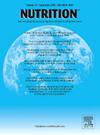Exploring the association between human breast milk lipids and early adiposity rebound in children: a case-control study
IF 3.2
3区 医学
Q2 NUTRITION & DIETETICS
引用次数: 0
Abstract
Objectives
Adiposity rebound (AR) corresponds to the start of the second rise in the body mass index (BMI) curve during infant growth. Early AR (before age 5) confers increased risk of adiposity and metabolic disorders but is less likely to occur in breastfed infants. Although lipids in breast milk is important in child growth, information is limited regarding which lipids involve in AR. The object of this study was to explore breast milk lipids associated with the AR status in children.
Methods
We designed a case-control study of 184 mother–child pairs (AR cases: n = 93; controls: n = 91) included from the Tohoku Medical Megabank Project Birth and Three-Generation (TMM BirThree) Cohort Study. Breast milk was collected one month postpartum and comprehensive lipid analysis was performed. Partial least square-discriminant analysis (PLS-DA) was used to explore candidate lipids, and multivariable logistic regression analysis was used to evaluate associations with the AR status of children.
Results
We detected 667 lipid molecules in 12 lipid classes in breast milk. PLS-DA revealed an association of fatty acid-hydroxy fatty acid (FAHFA) and cholesterol ester (ChE) with AR status. Multivariable logistic regression analysis showed that, in pairs with exclusive breastfeeding at one month postpartum, FAHFA (OR 1.57 [95% CI, 1.06–2.32]) was positively associated with early AR, and ChE (OR 0.55 [95% CI, 0.36–0.86]) was negatively associated.
Conclusions
Breast milk lipids (FAHFA, ChE) associated with the AR status of children, indicating the potential to regulate child's adiposity and possible metabolic disorders in adulthood.
探索人类母乳脂质与儿童早期肥胖反弹之间的关系:一项病例对照研究
目标肥胖反弹(AR)相当于婴儿生长过程中体重指数(BMI)曲线第二次上升的开始。早期反弹(5 岁前)会增加肥胖和代谢紊乱的风险,但母乳喂养的婴儿发生反弹的可能性较小。虽然母乳中的脂质对儿童的成长很重要,但有关哪些脂质参与 AR 的信息却很有限。我们设计了一项病例对照研究,研究对象是东北医学大型数据库项目出生和三代人(TMM BirThree)队列研究中的184对母子(AR病例:93人;对照组:91人)。采集产后一个月的母乳并进行全面的血脂分析。结果 我们在母乳中检测到 12 类脂质中的 667 种脂质分子。PLS-DA 发现脂肪酸-羟基脂肪酸 (FAHFA) 和胆固醇酯 (ChE) 与 AR 状态有关。多变量逻辑回归分析表明,在产后一个月纯母乳喂养的配对中,FAHFA(OR 1.57 [95% CI, 1.06-2.32])与早期 AR 呈正相关,ChE(OR 0.55 [95% CI, 0.36-0.86])与早期 AR 呈负相关。
本文章由计算机程序翻译,如有差异,请以英文原文为准。
求助全文
约1分钟内获得全文
求助全文
来源期刊

Nutrition
医学-营养学
CiteScore
7.80
自引率
2.30%
发文量
300
审稿时长
60 days
期刊介绍:
Nutrition has an open access mirror journal Nutrition: X, sharing the same aims and scope, editorial team, submission system and rigorous peer review.
Founded by Michael M. Meguid in the early 1980''s, Nutrition presents advances in nutrition research and science, informs its readers on new and advancing technologies and data in clinical nutrition practice, encourages the application of outcomes research and meta-analyses to problems in patient-related nutrition; and seeks to help clarify and set the research, policy and practice agenda for nutrition science to enhance human well-being in the years ahead.
 求助内容:
求助内容: 应助结果提醒方式:
应助结果提醒方式:


